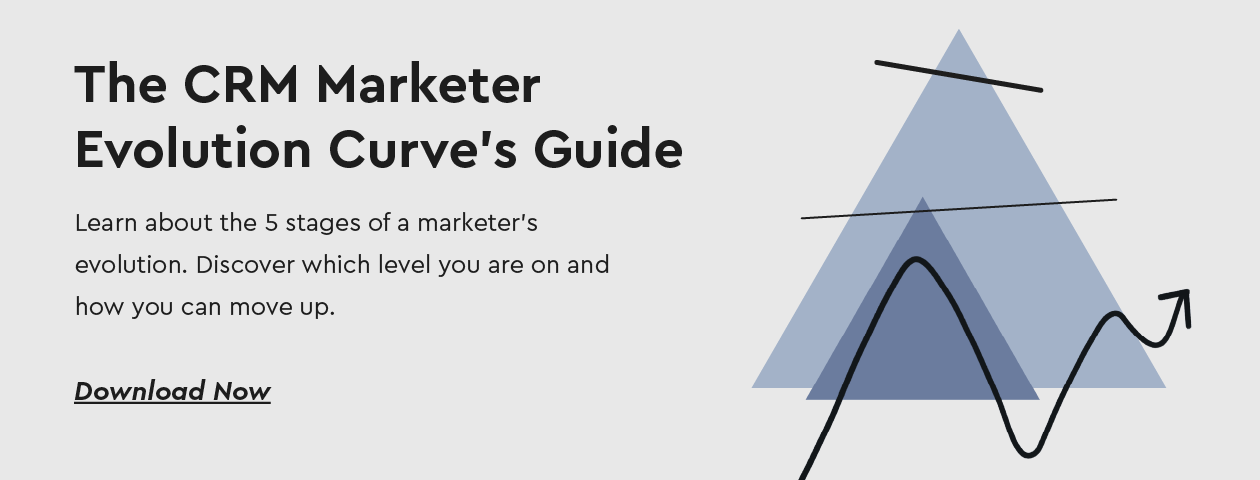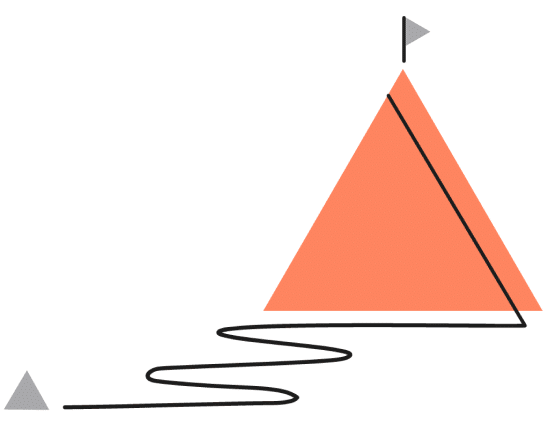What is a Customer Journey?
When talking about a customer journey, it refers to the customer’s complete experience when interacting with a brand. It begins with the first moment of awareness and continues through consideration, the first purchase, post-purchase engagement, repeat purchase, advocacy, and so on.
At its core, the customer journey includes every touchpoint and interaction with a company, and the emotions, decisions, and challenges experienced at each stage. Understanding the customer journey is crucial for brands that want to deliver personalized interactions, increase conversions, and build long-term customer relationships.
The CRM Marketer evolution curve
The 5 Stages of the Customer Journey
Below are the fives main stages of the customer journey and a corresponding marketing strategy and example of each:
- Awareness: Customers become aware of a brand, service, or product.
Marketing strategies: Social media, display advertising, SEO, and content marketing.
Example: A customer sees an ad on Instagram and becomes aware of the brand.
- Consideration: Customers begin comparing options and exploring solutions.
Marketing strategies: Product comparisons, testimonials, educational content, and case studies.
Example: A customer visits a website or reads a blog post.
- Decision (Purchase): The moment of conversion, customers decide to buy.
Marketing strategies: Clear calls to action, promotional offers, and a simplified checkout process.
Example: A customer signs up for a demo.
- Retention: Customers engage with the brand post-purchase and can become repeat buyers.
Marketing strategies: Onboarding emails, loyalty programs, personalized product recommendations, and re-engagement campaigns.
Example: Customer enters an email sequence and makes an additional purchase.
- Advocacy: Delighted customers promote the brand to others through marketing strategies that include referral incentives, user-generated content, reviews, community building, and more.
Marketing strategies: Referral incentives, user-generated content campaigns, social proof, community-building initiatives, and VIP programs.
Example: Customer leaves a review and shares the purchased items on TikTok.

The Importance of Understanding the Customer Journey in Marketing
Every customer interacts with brands uniquely, non-linearly, and each interaction leaves an impression. That’s why mapping the customer journey is essential: it enables marketers to understand and anticipate customer behavior, align efforts across teams, and deliver personalized and meaningful experiences at scale.
To deliver truly impactful marketing, brands must view their experiences through the eyes of their customers and this means considering non-marketing touchpoints, such as customer service. Mapping the customer journey allows marketers to understand the whole experience, from first interaction to long-term loyalty, and uncover the moments that matter most. It’s not just about data collection. It’s about using that insight to drive more relevant, personalized, and effective marketing across the entire lifecycle.
Personalizing Customer Experiences: By knowing where a customer is in their journey, marketers can tailor content and offers that meet their exact needs.
Optimizing Customer Touchpoints: Each stage presents opportunities to influence the customer’s decisions. Mapping the journey helps identify which touchpoints have the greatest impact.
Improving Customer Retention: Addressing pain points and exceeding expectations increases the likelihood of continued engagement and brand loyalty.
Boosting ROI: Strategic messaging delivered at the right time ensures efficient use of marketing budgets.
Building Long-Term Relationships: Moving beyond a single transaction and fostering brand loyalty is key to long-term growth.
Customer journey mapping isn’t just a strategic exercise. It’s a practical tool for unlocking better customer experiences and therefore marketing performance. When done right, it aligns your entire business around the customer, uncovers new opportunities, and drives smarter, faster execution. It empowers brands to meet customers where they are, with the right message and time, turning one-time buyers into lifelong advocates.
How to Map the Customer Journey
Customer journey mapping helps marketers make sense of the chaos. Today’s buyers don’t move in straight lines; they bounce between channels, research competitors mid-flow, and decide on their terms across devices, online and offline. That’s why mapping isn’t just helpful, it’s crucial. It allows marketers to understand what customers are doing, why, and most importantly, what to do next.
Mapping the customer journey is about more than documentation. It’s a strategic process that empowers brands to deliver timely, relevant, personalized experiences across every lifecycle stage and every marketing channel and touchpoint.
With today’s customers navigating complex, non-linear paths, journey mapping helps marketers identify what influences behavior, where friction exists, and how to optimize every touchpoint for maximum impact. It lays the foundation for transforming passive journeys into dynamic, orchestrated ones that drive long-term loyalty and growth.
Why Mapping is Crucial
Mapping the customer journey is crucial because it allows brands to visualize the path customers take. It uncovers gaps, friction points, and missed opportunities allowing brands to attain maximum engagement.
Tools for Mapping
There are different types of tools for mapping the customer journey. Effectively mapping and managing the customer journey requires strategic thinking, data-driven insight, and advanced technology. These tools form the foundation for identifying, understanding, and optimizing customers’ complex and non-linear paths. When used together, they enable marketers to transition from static journey maps to dynamic, personalized, and orchestrated customer experiences.
Journey Mapping Software: Journey mapping platforms help visualize customer touchpoints and interactions throughout the lifecycle. Traditionally, these tools rely on flowchart-based frameworks, which help plan predictable or typical paths, especially for new customer onboarding. However, in today’s environment of infinite journey variations, these static maps are best used as a foundational guide, along with more agile tools that can adapt in real-time to behavioral changes. The real value lies not in the visualization alone, but in how these maps evolve into orchestrated customer-led journeys.
Analytics Platforms: Analytics tools empower marketers to collect and interpret behavioral, transactional, and engagement data across channels. They provide insights into where customers are in their journeys, which campaigns resonate, and where drop-offs or friction points occur. Within an orchestration framework, analytics drive predictive modeling, enabling brands to anticipate customer actions and intervene with the right message at the right time. This analytical depth transforms passive observation into actionable intelligence.
Buyer Personas: Buyer personas represent archetypal customer profiles based on shared characteristics, behaviors, goals, and challenges. While personas help structure the types of journeys different customer segments might experience, they are only the starting point. Optimove enhances this approach with behavioral micro-segmentation, dynamically clustering customers based on real-time data rather than assumptions. This shift from static personas to fluid micro-segments ensures that personalization is not just theoretical but operationalized at scale.
CRM Data: Customer Relationship Management (CRM) systems house rich historical data, including purchases, interactions, support tickets, demographic information and more. This data provides the backbone for understanding customer preferences and lifecycle stages. In journey orchestration, CRM data fuels dynamic segmentation and helps define the “behavioral DNA” of each customer. Optimove integrates CRM data to identify high-value micro-segments and deliver personalized journeys that evolve based on past and predicted actions.
Customer Feedback: Direct input from customers via surveys, reviews, Net Promoter Score (NPS) scores, and support interactions offer qualitative insights into the emotional side of the customer journey. It identifies gaps that data alone may not reveal, such as frustration points or unmet expectations. Feedback loops also inform optimization, allowing brands to refine journey orchestration based on real-world experiences. Optimove empowers marketers to combine this feedback with predictive data to craft more empathetic and effective engagements.
By leveraging these tools holistically, marketers can move beyond pre-defined funnels to orchestrate infinite, real-time journeys tailored to individual customers. The goal is not just to understand what a customer has done, but to anticipate where they’re going, and meet them there with the right message, channel, and timing to maximize retention and customer loyalty.
The CRM Marketer Evolution Curve’s Guide
Learn about the 5 stages of a marketer’s evolution. Discover which level you are on and how you can move up.
How Optimove Helps in Customer Journey Mapping
Optimove helps brands activate and evolve journey maps through AI-powered orchestration. The platform allows marketers to seamlessly coordinate personalized interactions across all channels, ensuring that every customer receives the right message at the right time. Here’s how each feature contributes to effective customer journey mapping and orchestration:
Predictive Customer Modeling
Optimove uses advanced machine learning (ML) to anticipate what customers do next when engaging with a brand. Whether it’s predicting churn, identifying potential VIPs, or forecasting the best time for a follow-up message, this modeling allows marketers to intervene at critical moments in the journey or simply send a friendly email with the latest deals. Predictive customer modeling lets brands spot when a customer is starting to disengage, so they can step in with a retention campaign before losing them.
AI-Driven Segmentation
Not all customers are the same; static segments often fail to reflect current behaviors. Optimove’s AI continuously updates customer segments based on real-time data and behavioral trends. This ensures that customers are grouped into the most precise customer segments to receive messages tailored to their current needs, preferences, and expectations.
Multichannel Campaign Orchestration
Customers interact with brands across multiple platforms. Optimove ensures these experiences are connected and consistent by orchestrating email, mobile, push, SMS, web, and more campaigns. Instead of sending isolated messages, marketers can design and deploy coordinated journeys that adapt to customer actions on any channel, without overlapping or conflicting communications.
Real-Time Personalization
Journey stages are fluid, not fixed. Optimove enables real-time updates to messaging and campaign flows based on a customer’s most recent behavior. If a customer moves from consideration to purchase, the next communication instantly reflects this change, ensuring they’re never sent outdated or irrelevant messages. This keeps the journey timely and customer-centric.
Customer Behavior Analytics
Understanding what works and why is critical for optimizing journey performance. Optimove tracks every customer interaction and its downstream effect, giving marketers deep insights into which campaigns, channels, and touchpoints are most effective to use each and every time. This continuous feedback loop helps refine strategies, improve messaging, and enhance customer experience over time.

Why Positionless Marketing is Key to Customer Journey Optimization
Delivering seamless customer journeys at scale requires more than data; it needs executional agility. Positionless Marketing empowers marketers to act instantly on insights, removing internal silos and bottlenecks. With Data Power, Creative Power, and Optimization Power at their fingertips, any team member can independently design, launch, and refine hyper-personalized journeys across channels. This allows brands to respond to customer behavior as it happens to deliver timely, relevant experiences that drive results.
In Summary
Optimove turns traditional, static customer journey maps into intelligent, responsive experiences. Each feature contributes to a more seamless, personalized, and effective journey for every customer, whether new to the brand or long-time loyalists.
For more insights, contact us to request a demo.
Frequently Asked Questions
Does journey orchestration differ from personalization?
Yes, journey orchestration and personalization are related but distinct strategies. Personalization focuses on individual touchpoints, customizing messages or offers based on customer attributes or preferences. Journey orchestration goes further by managing the entire customer journey in real-time, ensuring consistent, personalized experiences across all channels. It uses automation and data-driven insights to determine and deliver the next-best-action at every stage. Together, they enhance engagement, but orchestration ensures the journey flows smoothly and meaningfully.
What is the buyer’s journey?
The buyer’s journey is the process customers go through when making a purchasing decision. It typically includes three stages: awareness, consideration, and decision-making. At each stage, customers seek different types of information and engagement. Understanding this journey helps marketers deliver the right message at the right time – every time.
Get a personalized tour of Optimove
Let us show you how to go from tens to hundreds of segments

